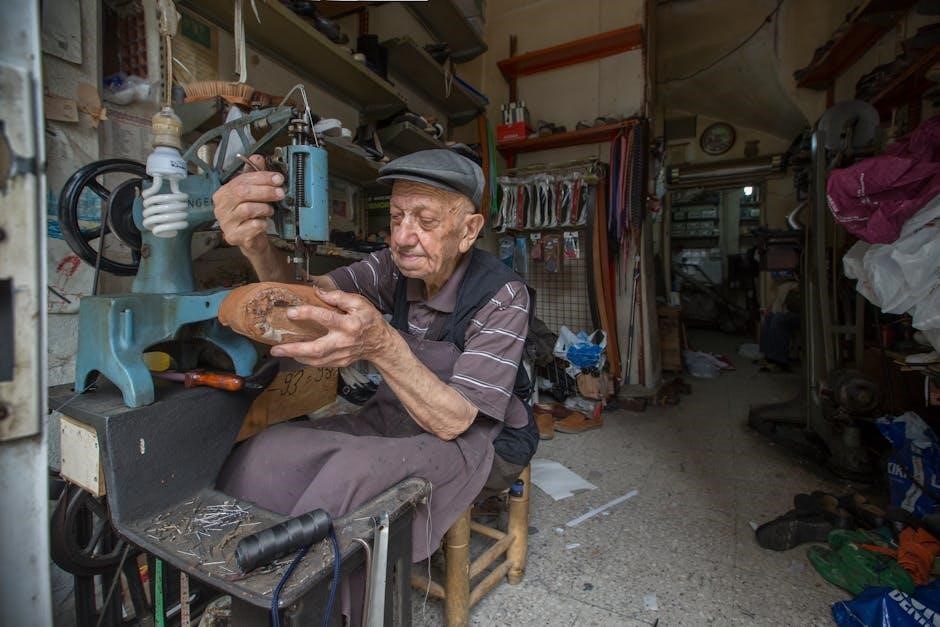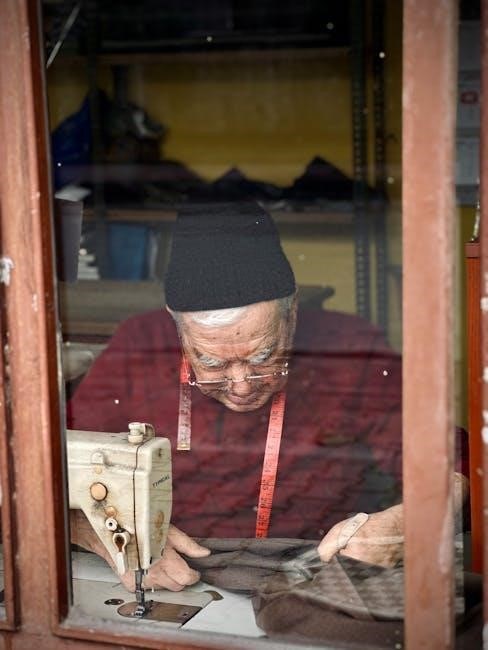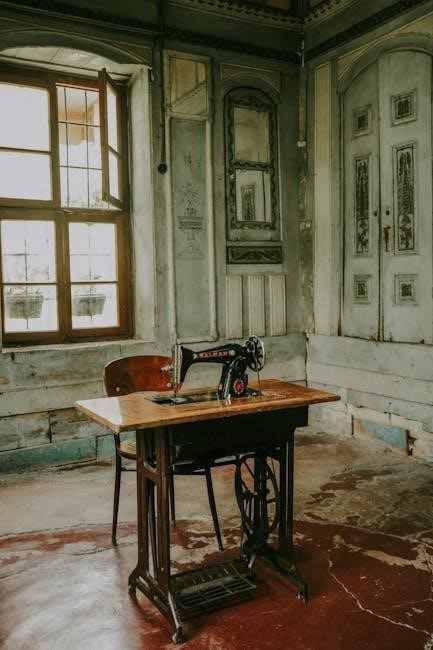old singer sewing manuals
- by leo

Singer sewing machine manuals offer a wealth of information for collectors and users of vintage machines. These manuals provide instructions for operation, maintenance, and troubleshooting. They are essential for identifying models and understanding their history.
Identifying Your Singer Sewing Machine Model
Identifying your Singer sewing machine model is the first step to finding the correct manual. Model numbers are often found on the machine’s front, base, or back. These numbers, often 3 or 4 digits, help narrow down your search.
Using Serial Numbers for Identification
Singer sewing machine serial numbers are crucial for accurate identification. These numbers, located near the on/off switch on newer models or in other locations on older machines, can unlock a wealth of information about your machine’s history. By consulting serial number databases, you can determine the manufacturing date and sometimes the specific model.
The International Sewing Machine Collectors Society fosters research into sewing machines, using serial numbers for identification. Pre-1960 cast metal Singers can often be identified using serial numbers. Remember that some dating information has been removed from Singer’s official website. Always use reliable sources.
Visual Identification Guides
Visual identification guides are invaluable tools for recognizing Singer sewing machine models, especially those manufactured before 1960. These guides often feature photo galleries of various vintage models, enabling quick and easy identification based on appearance. Models like the 66, 99, 201, and Featherweights have distinct visual characteristics.
Key features to observe include the machine’s shape, any visible logos, and the presence of specific attachments. Sandman Collectibles offers an excellent online identification guide. Remember that post-1960s machines might have a logo featuring a figure working on a sewing machine. Use multiple resources to confirm your identification.

Accessing Singer Sewing Machine Manuals
Finding manuals for old Singer sewing machines is easier than you might think. Several online resources offer downloadable manuals, often in PDF format. These resources can help with operating and maintaining your vintage machine.
Online Resources for Manuals
Numerous websites are dedicated to preserving and sharing Singer sewing machine manuals. These online resources often host scanned copies of original manuals, which can be downloaded for free or for a nominal fee. Collectors’ forums and vintage sewing machine communities are also excellent places to find manuals, as members often share resources and information. Some sites even offer visual identification guides to help you determine your machine’s model number, which is crucial for locating the correct manual. Be sure to check resources like the International Sewing Machine Collectors Society for access to manuals and to foster the collecting of sewing machines.
Singer’s Official Website and Manuals
Singer’s official website is a valuable resource for obtaining manuals, although they may not have all the old ones. Modern Singer machines usually have their model numbers clearly visible on the front or base. For older models, the website might offer some general guides or information. It is recommended to explore their support section for downloadable resources. The website may also provide links to authorized service centers that have access to a more extensive collection of manuals. Keep in mind that Singer has pulled some dating and identification information from its website recently, so it might not be as comprehensive as third-party sources.

Understanding Serial Numbers and Production Dates
Serial numbers are crucial for determining a Singer’s production date and model. These numbers help trace the machine’s history and origin. Databases and guides exist to decode these serial numbers effectively.
Dating Your Machine Using Serial Number Databases
To accurately determine the age of your vintage Singer sewing machine, utilizing serial number databases is essential. These databases, often compiled by collectors and historical societies, correlate serial numbers with production dates and factory locations. Inputting your machine’s serial number into these resources can reveal its manufacturing year, offering insights into its history.
Several online resources, such as the International Sewing Machine Collectors Society and Sandman Collectibles, provide serial number lookup tools and guides. These tools often present tables showing serial number ranges and their corresponding production periods. Some sites even offer additional information about the machine’s features and original intended use.
Keep in mind that Singer sometimes issued serial number series out of sequence, so cross-referencing information from multiple sources is advisable.
Serial Number Location on Different Models
The location of the serial number on a Singer sewing machine varies depending on the model and year of manufacture. On older, cast-iron machines, the serial number is typically found on the bed of the machine, often near the motor or under the bobbin plate. It may be stamped into the metal or printed on a small metal plate affixed to the machine.
For newer vintage Singer models, particularly those from the mid-20th century onward, the serial number is commonly located on the base of the machine, near the on/off switch, or on a plate at the back or front of the machine. Portable models may have the serial number on the underside of the machine or inside the carrying case.
Consulting model-specific manuals and identification guides can provide precise instructions on locating the serial number for your particular Singer machine.
The Value of Antique and Vintage Singer Sewing Machines
The value of antique and vintage Singer sewing machines hinges on factors like rarity, condition, and historical significance. Some models fetch high prices among collectors, while common ones may have sentimental value.
Factors Affecting Value: Rarity and Condition
The value of an antique or vintage Singer sewing machine is significantly influenced by its rarity and condition. Machines produced in limited quantities or during specific historical periods tend to be more valuable to collectors. The physical state of the machine, including the presence of original parts, the integrity of the finish, and the absence of damage or wear, plays a vital role in determining its worth. A well-preserved machine in excellent working order will generally command a higher price than one that is heavily used, damaged, or missing components. Rarity is a key factor affecting value. Many common models were made in their millions. These machines are extremely long-lasting. Thus, many of them are still around.

Common Singer Sewing Machine Models and Their Manuals
Many Singer sewing machine models exist, each with unique features and corresponding manuals. Understanding these models and accessing their specific manuals is crucial for maintenance, repair, and optimal usage.
Singer Featherweight (221, 222K) Manuals
The Singer Featherweight 221 and 222K models are highly sought after by collectors and seamstresses alike. These machines are known for their portability and reliable performance. Their manuals are essential for understanding their unique features and maintenance requirements. These manuals offer detailed instructions on threading, bobbin winding, stitch adjustments, and basic troubleshooting.
Accessing the correct manual is vital for preserving and enjoying these iconic machines. Many online resources provide downloadable versions of these manuals, ensuring that users can keep their Featherweights running smoothly for years to come.
Manuals for Other Popular Vintage Models (66, 99, 201)
Beyond the Featherweight, Singer produced numerous other popular vintage models, including the 66, 99, and 201. Each of these machines has its own unique characteristics and requires specific maintenance procedures. Original manuals for these models are invaluable resources for owners seeking to restore or maintain their machines.
These manuals typically include detailed diagrams, threading instructions, and troubleshooting tips. They also provide guidance on adjusting tension, cleaning, and oiling the machines. Accessing the correct manual ensures that users can properly care for their vintage Singer sewing machines and keep them in optimal working condition.

Troubleshooting with Old Singer Manuals
Old Singer manuals are invaluable for troubleshooting. They offer solutions for common issues, including tension problems and stitch irregularities. These manuals provide detailed instructions and diagrams to help users resolve mechanical issues.
Common Issues and Solutions Found in Manuals
Singer sewing machine manuals often address common issues like thread breakage and skipped stitches. Solutions include adjusting tension settings and ensuring proper threading. Manuals provide guidance on cleaning and oiling, essential for smooth operation. They also detail how to replace worn parts and adjust timing. Understanding these solutions enhances the longevity of vintage Singer machines.
Specific problems, such as bobbin winding malfunctions, are covered with step-by-step instructions. Illustrations and diagrams aid in understanding complex mechanisms. Singer manuals offer insights into addressing fabric feeding problems and needle positioning errors. These resources are invaluable for maintaining and repairing your sewing machine.
Tension Problems and Adjustments
Singer sewing machine manuals dedicate significant attention to tension problems, a frequent issue. The manuals detail how to diagnose and correct tension imbalances affecting stitch quality. They explain the relationship between upper and lower thread tension. Illustrations show the location of tension adjustment dials and screws.
Proper adjustments are crucial for achieving balanced stitches, preventing puckering or looping. Manuals guide users through testing tension using different fabrics and threads. They offer advice on cleaning tension discs to remove lint and debris. Understanding tension adjustments ensures optimal sewing performance. Correcting tension issues prolongs the life of the machine.
Related posts:
Lost your old Singer sewing machine manual? We’ve got tons! Download free PDFs and get sewing again. Vintage Singer manuals are waiting!
Posted in Manuals